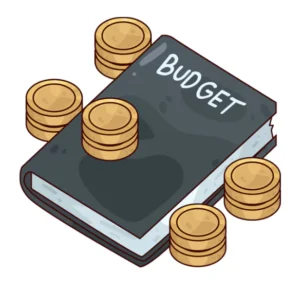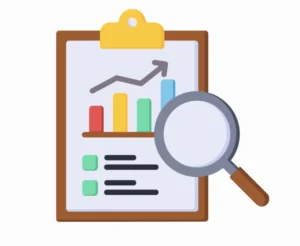Launching a product or service without a clear understanding of the market in this fast-changing era is difficult. To not only survive but get success, a comprehensive Market Research, competitor research and analysis is not just an option it’s a necessity. This is a two-way process that give clarity in decision making process. Decision making is necessary to define your market, understand your customers, position your brand, and fight your rivals.
This will guide you through essential stages and steps on how to conduct a market and competition analysis, to turn raw data into actionable strategies that result in growth.
What is Market Research to Competitive Analysis?
These two terms in competitor research and analysis usually refer to the same thing, yet they mean two separate but equally important phases of strategic planning.

Market Research : It identifies the customers and the whole industry. It answers questions such as, What is this customer? What are the customers’ issues? How large is the market? What are the important trends in the industry?
Competitive Analysis: It answers the questions such as Who are my competitors? What are their strengths and weaknesses? How can I differentiate my offering?
Lets explore what is competitive analysis explain with examples.
Example 1: New Coffee Shop:
Discoveries in Market Research: Local residents are seeking convenience and fast service during early morning hours (customer needs/market trend).
Findings of Competitive Analysis: Competitor A has the best coffee beans but has an extremely slow speed. Competitor B has good speed, but with lousy coffee.
Strategy : This new shop invests in premium-grade, automated espresso machines for high-quality, fast service, filling a crucial gap identified by both market and competitor research and analysis.
Example 2: A SaaS Software Startup
Market Research Finding: Small business owners are highly price-sensitive and struggle to integrate current tools with their existing accounting software (customer problem/market segment).
Competitive Analysis Finding: Competitor X is feature-rich but expensive. Competitor Y is cheap but lacks necessary integration features.
Strategy: The start-up targets a low-cost, simplified version of the software with a specific emphasis on key accounting software integrations, highlighting this unique blend in all its marketing to capture the underserved small business segment.
Ways in Which Market Research Reach Customers
Competitor research and analysis research combined with market research is the foundation for any successful strategy, consisting of identifying the target audience and delving into the entirety of what surrounds the person.
Key Steps in Initial Market or Competitor Research and Analysis
Target Audience: Define Your Target Audience (The “Who”):
- Demographics & Psychographics: Covering age, income, education, and location, as well as their interests, values, and lifestyle.
- Pain Points & Needs: Conduct surveys or interviews to discover the specific, unsolved problems or frustrations they currently face that your product can address.
- Purchasing Behavior: Determine where they shop, what devices they use, and what information sources (blogs, social media, review sites) they rely on before making a purchase.
Estimate Market Size and Trends (The “How Big”):
- Total Addressable Market (TAM): Compute that maximum possible revenue you would earn if you owned the entire relevant market.
- Market Segmentation: Cut that broad market into different segments having needs and characteristics in common and thereby can be used to apply resource focus.
- Current Trends: Analyze the major-shifting tetns in technology, economy, or consumerism affecting the industry to present early opportunities or signifying future threats e.g., rise of AI, sustainability demands. analyze.
Analyze Barriers to Entry:
- Capital & Resource Needs: Explore possible investment of capital & humanresource to find out how feasible it can to set up a viable business in that space.
- Regulatory Hurdles: Acquire some knowledge as to whether compulsory licensing, permits, or other intricate compliancy requirements exist, which competitors already put behind them.
Types of Competitor Analysis and Research
Competitor research and analysis is unique and completely separate. Usually, it overlaps with other types of research to achieve a complete view of a given rival strategy.
Types of Competitive Analysis
Product/Service Analysis:
- Feature Mapping: Draw a chart indicating a side-by-side comparison of your products’ features comparing them with those of your main contenders. This chart will help define competitive advantages and the competitive gaps.

- Usability Testing: Evaluate however comparatively directly the usability (UX) and overall product quality of competitor products through testing.
- Review Mining: Systematically gather and classify customer reviews to find out what consumers hate and love about specific competitor features or functionality.
Digital Marketing Analysis:
- SEO/content audit: Employing tools, SEMrush and Ahrefs to name a few, to uncover top-performing keywords, estimate organic traffic, and discover the core content pillars.
- Paid Advertising Strategy: Understand their customer acquisition funnel and budget by analyzing their ad copy, image assets, and landing pages across platforms such as Google Ads and Meta.
- Social Media Benchmarking: Engaging competitors’ social channels to compare the engagement rates, follower growth, and tone of voice for most effective communication strategies.
Strategic & Financial Analysis:
- SWOT analysis: Carrying out a formal assessment of one’s own and a rival’s strengths, weaknesses, opportunities, and threats in defense of one’s differentiation.

- Pricing Structure Analysis: Competitor pricing structures would include examining list prices, discount policies, bundling offers, and prices for premium tiers while seeking a profitable price position for oneself.
- Sales Process Mapping: Walk down all customer steps from start contact to final purchase (e.g., free demo, 7-day trial, required sales call) in search of any points of friction to simplify.
How to Study Competitors for Competitive Research and Analysis
When you are familiar with your market and consumer, doing competitor research and analysis becomes a systematic study. Lets dive into competitor research and analysis example, their product and pricing strategy.
Competitor Research and Analysis Notes:
- Core Offering USPs: Analyze their main products, features, and USPs, and take note of any recent feature additions or discontinuation decisions.
- Pricing Structure: Document all pricing models (subscription tiers, freemium, one-time purchase, etc.) and the features that fall within each price point.

- Product Quality: Review customer reviews on third-party sites (G2, Trustpilot) in order to understand product reliability, user experience (UX), and what general customer complaints are.
Sales and Distribution Strategy:
- Sales Channel: Which channels utilize them-direct selling online, offline physical retail network, or strategic partnerships/distributors to reach their customers.
- Sales Model: Is it self-service e-commerce or relies on a much more human face-to-face sales team (B2B enterprise deals)?
- Promotional Techniques: Any consistent sales promotion techniques, i.e. discounts offered on holidays, annual discounts, or impressive referral programs.
Marketing and Content Strategy:
- Digital Footprint (SEO/PPC): Discover their highest ranking keywords and what content (i.e. blogs, videos, etc.) really drive home that organic traffic and what they fill their paid ads with.
- Social Engagement: Active platforms (TikTok, LinkedIn), brand voice created, and types of posts with very high audience engagement.
- Email Marketing: Sign up for newsletters, note down the frequency, types, and focuses of messages for understanding how they are retaining their customers.
Technology and Operations:
- Technology Stack: Understand the basic tools and software that make up the backbone of their website, CRM, or automation, showing, quite often, where they either fall short or have strength in scalability.
- Customer Service: Test responding time and some knowledge and availability (24/7 vs. business hours) of their support channels (chat, email, phone), test scalability (scale of operations).
Business Data and Trends
As you use objective market and competitor data, research becomes the most potent strategy.
Key Data Points for Strategic Decision-Making
Market Share and Growth Rate:
- Market Share: Determine the percentage of the total market revenue that your key competitors control, indicating their dominance.
- Growth Trajectory: Year-on-year revenue or user growth rates would reveal growing challengers and stagnant incumbents.

- Geographic Expansion: Monitor new office openings or marketing campaigns that competitors are doing to see where their next target market is.
Finances and Funding:
- Funding Rounds: Follow the money trails on recent funding rounds for a privately held company (Seed, Series A, B, etc.) to see how much faith is given by investors in one’s growth and what war chest is available for marketing/development.
- Pricing Flexibility: Understand their gross profit margins (if possible to estimate) to know how low they can afford to drop prices to obtain market share.
- Hiring Trends: Read job postings to find what areas are investing strategically (hiring many AI developers suggests product focus).
Industry and Technology Trends:
- Platform Transitions: Major, generally industrywide migrations, as in the cloud, or new regulations such as data privacy laws.
- Emerging Technologies: New technologies (e.g., Generative AI integration, Blockchain) that will fundamentally alter the product category over the next 1-3 years.
- Consumer Sentiment: Measure how consumer sentiment shifts from overall, consumer-type products by analyzing sentiment tracking tools according to the big changes in society (e.g., economic downturn, sustainability-focused).
Benefits of Competitor Research and Analysis
What competitor research and analysis does is so deep that it actually speeds up the business success curve, while simultaneously reducing the chances of risk.
Key Benefits of a Competitor Research and Analysis
Shows Unique Market Opportunities:
- Feature Gaps: Identify features that are wanted by customers but not currently offered by any competitor creating what can be an immediate differentiator.
- Underserved Segments: Identify certain customer groups (freelancers, verticals) that the competition ignores or poorly serves.
- Pricing Gaps: Identify sweet spots in the market from either too high or too low competitor pricing, allowing perfect positioning of your product.
Informs and Validates Your Strategy:
- Risk Mitigation: Understand competitor weaknesses, which will keep you from repeating the same costly mistakes.
- Resource Allocation: Judging by activity in this market, which marketing channels (e.g., LinkedIn, YouTube) or distribution efforts are proven successful, thus preventing wasted spending.
- Strategic Positioning: Clearly define your unique value proposition (UVP) while contrasting it directly against your rivals’ weaknesses.
Enables Proactive Decision-Making:
- Anticipate Moves: You can often guess what a competitor is likely going to do next in its strategy based on their announcing a hire or product (a focus on a mobile app, or geographic expansion).
- Benchmark Performance: Set simple metrics that can guide you in knowing how well or not it is performing against another.
- Improve Sales Pitches: Equip the salesforce with specific, evidence-based points of differentiation one can use against specific competitors with negotiations.
Taking Actions on Your Insight
The processes of market, competitor research and analysis are not a one-time but an ongoing endeavor to keep your business strategy flexible, relevant, and superior to the competition. Moving from assumption to unquestionable insight of the data allows you to ride confidently the challenges of the market and accelerate your growth.

The Final Key Takeaways for Success in Competitor Research and Analysis
- Focus on Segmentation: Don’t attempt to serve everybody; do some market research to find the most profitable but underserved customer segment.
- Focus on Differentiation: The SWOT analysis will help you inform precisely about what you’re doing better or differently from its very competitors.
- Validate Pain Points: Make sure your product is solving a real articulated customer problem and not just perceived.
- Monitor Constantly: Set up some simple ongoing methods of tracking (Google Alerts for competitor names is one example) so you’re always ahead of sudden market or competitor changes.
- Translate Data into Action: Every research result must lead to any sort of specified action-whether that means changing price, developing new features, or revising your marketing copy.
Mastery in Digital Strategy and Analysis
Would you like to gain the in-depth skills required to conduct competitor research and analysis successfully? PW Skills has an excellent Digital Marketing course that is relevant for anyone wishing to kick-start or progress their career in this fast-evolving sector. You’ll master advanced SEO tools and data-driven content strategies to accrue organic traffic that converts high, thereby making you ready for the market in a matter of months.
It identifies market gaps, helps you think ahead toward following constrained novelty contesting moves, and aids in creating a value proposition offering uniqueness that is going to be picked by the customer. It should be a major review at least twice a year. In addition, you need to keep constant surveillance on the key players for any major changes/new campaigns that might arise. Competitor research requires utility tools like SEMrush, SimilarWeb for Web traffic analysis, and social media listening tools. A business that solves the same customer problem but with a different product or service from yours (e.g. cinema as indirect competitor to streaming service).FAQs
Why is competitor analysis important?
How frequently should I do competitors' evaluations?
What are the top tools for competitor research?
What is indirect competitor?

